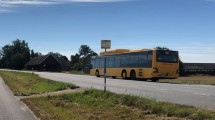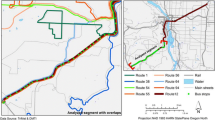Abstract
The focus of this study is to examine the association between bus transit reliability and the number of boarding passengers at bus-stop level using data obtained from the Charlotte Area Transit System (CATS) in the city of Charlotte, North Carolina, USA for the year 2017. The on-time performance percentage was computed and used as bus transit reliability at bus-stop level. Two different thresholds were considered to compute the on-time performance measure. The ridership data was processed to compute the average number of boarding passengers per bus at bus-stop level. The findings indicate that the day of the week, time of the day, direction of travel, and the type of bus-stop influence the association between the on-time performance percentage and the average number of boarding passengers per bus.



Similar content being viewed by others
Data availability
The datasets generated during and/or analysed during the current study are available from the corresponding author on reasonable request.
References
Abdel-Aty MA (2001) Using ordered probit modeling to study the effect of ATIS on transit ridership. Transp Res Part C: Emerg Technol 9(4):265–277
Abenoza RF, Cats O, Susilo YO (2017) Travel satisfaction with public transport: determinants, user classes, regional disparities and their evolution. Transp Res Part A: Policy Practice 95:64–84
Albassam M, Khan N, Aslam M (2021) Neutrosophic D’Agostino test of normality: an application to water data. J Math 2021:5582102
Bertini RL, El-Geneidy A (2003) Generating transit performance measures with archived data. Transp Res Rec 1841(1):109–119
Bhattacharjee S, Goetz AR (2016) The rail transit system and land use change in the Denver metro region. J Transp Geogr 54:440–450
Brakewood C, Macfarlane GS, Watkins K (2015) The impact of real-time information on bus ridership in New York City. Transp Res Part C: Emerg Technol 53:59–75
CDOT (Charlotte Department of Transportation) (2022) Charlotte moves strategic mobility plan state of mobility. https://charlottenc.gov/Mayor/Charlotte_Moves_Task_Force/Documents/Charlotte_MOVES_State_of_Mobility_October_2020.pdf. Accessed 19 Oct 2021
Cervero R (1994) Transit-based housing in California: evidence on ridership impacts. Transp Policy 1(3):174–183
Chakrabarti S (2017) How can public transit get people out of their cars? An analysis of transit mode choice for commute trips in Los Angeles. Transp Policy 54:80–89
Chen X, Yu L, Zhang Y, Guo J (2009) Analyzing urban bus service reliability at the stop, route, and network levels. Transp Res Part A: Policy Practice 43(8):722–734
Chepuri A, Jairam R, Arkatkar SS, Joshi G, Pulugurtha SS (2018) Examining travel time reliability-based performance indicators for bus routes using GPS-based bus trajectory data in India. ASCE J Transp Eng Part A: Syst 144(5):04018012. https://doi.org/10.1061/JTEPBS.0000109
Chepuri A, Arkatkar SS, Joshi G, Pulugurtha SS (2020) Assessing value of bus transit passenger’s travel time and savings: a case study of Mumbai, India. Int J Transp Econ XLVII(3):255–272. https://doi.org/10.19272/202006703002
Choi J, Lee YJ, Kim T, Sohn K (2012) An analysis of Metro ridership at the station-to-station level in Seoul. Transportation 39(3):705–722. https://doi.org/10.1007/s11116-011-9368-3
Currie G, Delbosc A (2011) Understanding bus rapid transit route ridership drivers: an empirical study of Australian BRT systems. Transp Policy 18(5):755–764
D’Agostino RB (1986) Tests for the normal distribution. In: D’Agostino RB, Stephens MA (eds) Goodness-of-fit techniques. Marcel Dekker Inc., pp 367–419
Devi MK, Safitri R, Fanani F (2021) Does continuous improvement can push BRT ridership? (Case study of BRT TransJakarta). IJTI Int J Transp Infrastruct 4(2):169–178
Diab EI, Badami MG, El-Geneidy AM (2015) Bus transit service reliability and improvement strategies: Integrating the perspectives of passengers and transit agencies in North America. Transp Rev 35(3):292–328. https://doi.org/10.1080/01441647.2015.1005034
Duddu VR, Pulugurtha SS, Najaf P (2014) New transit performance measures and LOS criteria for link-level assessment. In: 93rd Annual meeting of the transportation research board, Washington DC
Duddu VR, Pulugurtha SS, Najaf P (2019) Using link-level archived automatic vehicle location data to assess transit system LOS at bus-stop level. Transp Dev Econ 5:11. https://doi.org/10.1007/s40890-019-0079-3
Forsyth A, Oakes JM, Lee B, Schmitz KH (2009) The built environment, walking, and physical activity: Is the environment more important to some people than others? Transp Res Part D: Transp Environ 14(1):42–49. https://doi.org/10.1016/j.trd.2008.10.003
Ge L, Voß S, Xie L (2022) Robustness and disturbances in public transport. Public Transport 14:191–261. https://doi.org/10.1007/s12469-022-00301-8
Graehler M, Mucci RA, Erhardt GD (2019) Understanding the recent transit ridership decline in major US cities: service cuts or emerging modes. In: 98th annual meeting of the transportation research board, Washington, DC
Guerra E (2014) The built environment and car use in Mexico City: is the relationship changing over time? J Plan Educ Res 34(4):394–408
Hörcher D, Graham DJ, Anderson RJ (2017) Crowding cost estimation with large scale smart card and vehicle location data. Transp Res Part B: Methodol 95:105–125
Hughes-Cromwick M (2019) 2019 public transportation fact book. American Public Transportation Association (APTA), Washington, DC, https://www.apta.com/wp-content/uploads/APTA_Fact-Book-2019_FINAL.pdf. Accessed 19 Oct 2021
Ishaq R, Cats O (2020) Designing bus rapid transit systems: lessons on service reliability and operations. Case Stud Transp Policy 8(3):946–953
Kathuria A, Parida M, Sekhar C (2020) A review of service reliability measures for public transportation systems. Int J Intell Transp Syst Res 18(2):243–255
Khattak AJ, Rodriguez D (2005) Travel behavior in neo-traditional neighborhood developments: a case study in USA. Transp Res Part A: Policy Practice 39(6):481–500. https://doi.org/10.1016/j.tra.2005.02.009
Kim S, Ulfarsson GF, Hennessy JT (2007) Analysis of light rail rider travel behavior: impacts of individual, built environment, and crime characteristics on transit access. Transp Res Part A: Policy Practice 41(6):511–522
Lai WT, Chen CF (2011) Behavioral intentions of public transit passengers—the roles of service quality, perceived value, satisfaction and involvement. Transp Policy 18(2):318–325
Levinson HS (2004) The new “transit capacity and quality of service manual”: tour of the expanded guide for transit planners and operators. TR News 232:25–33
Litman T (2016) The hidden traffic safety solution: Public transportation, American Public Transportation Association. https://www.apta.com/wp-content/uploads/Resources/resources/reportsandpublications/Documents/APTA-Hidden-Traffic-Safety-Solution-Public-Transportation.pdf. Accessed 19 Oct 2021
Mallett WJ (2018) Trends in public transportation ridership: implications for federal policy. https://sgp.fas.org/crs/misc/R45144.pdf. Accessed 19 Oct 2021
Nakanishi YJ (1997) Part 1: bus: bus performance indicators: on-time performance and service regularity. Transp Res Rec 1571(1):1–13. https://doi.org/10.3141/1571-01
Paudel J (2021) Bus ridership and service reliability: the case of public transportation in Western Massachusetts. Transp Policy 100:98–107
Pulugurtha SS, Agurla M (2012) Assessment of models to estimate bus-stop level transit ridership using spatial modeling methods. J Public Transp 15(1):33–52
Pulugurtha SS, Srirangam LP (2022) Pedestrian safety at intersections near light rail transit stations. Public Transport 14:583–608. https://doi.org/10.1007/s12469-021-00276-y
Pulugurtha SS, Vanapalli VK (2008) Hazardous bus stops identification: an illustration using GIS. J Public Transp 11(2):65–83
Pulugurtha SS, Nambisan SS, Srinivasan N (1999) Evaluating transit market potential and selecting locations of transit service facilities using GIS. J Public Transp 2(4):75–94
Pulugurtha SS, Duddu VR, Mora R (2011) Identifying inaccessible areas with potential to enhance transit market. J Public Transp 14(2):109–131
Pulugurtha SS, Penmetsa P, Duddu VR (2019) Travel time, reliability, additional trip time, willingness to pay and their values by socio-economic factors. Adv Transp Stud: Int J 49:31–46
Redman L, Friman M, Gärling T, Hartig T (2013) Quality attributes of public transport that attract car users: a research review. Transp Policy 25:119–127
Sharaby N, Shiftan Y (2012) The impact of fare integration on travel behavior and transit ridership. Transp Policy 21:63–70
Soza-Parra J, Raveau S, Muñoz JC (2022) Public transport reliability across preferences, modes, and space. Transportation 49(2):621–640
Strathman JG, Hopper JR (1993) Empirical analysis of bus transit on-time performance. Transp Res Part A: Policy Practice 27(2):93–100
Strathman JG, Dueker KJ, Kimpel T, Gerhart R, Turner K, Taylor P et al (1999) Automated bus dispatching, operations control, and service reliability: baseline analysis. Transp Res Rec 1666(1):28–36
Surprenant-Legault J, El-Geneidy AM (2011) Introduction of reserved bus lane: impact on bus running time and on-time performance. Transp Res Rec 2218(1):10–18
Syed SI, Khan AM (2000) Factor analysis for the study of determinants of public transit ridership. J Public Transp 3(3):1–17
Tirachini A, Hensher DA, Jara-Díaz SR (2010) Comparing operator and users costs of light rail, heavy rail and bus rapid transit over a radial public transport network. Res Transp Econ 29(1):231–242
Tirachini A, Sun L, Erath A, Chakirov A (2016) Valuation of sitting and standing in metro trains using revealed preferences. Transp Policy 47:94–104
Acknowledgements
This paper is prepared based on information collected for a research project funded by the United States Department of Transportation – Office of the Assistant Secretary for Research and Technology (USDOT/OST-R) University Transportation Centers Program (Grant # 69A3551747127). The authors thank CATS for providing data required for this study.
Author information
Authors and Affiliations
Corresponding author
Ethics declarations
Conflict of interest
This paper is disseminated in the interest of information exchange. The views, opinions, findings, and conclusions reflected in this paper are the responsibility of the authors only and do not represent the official policy or position of the University of North Carolina at Charlotte or other entity. The authors are responsible for the facts and the accuracy of the data presented herein. This paper does not constitute a standard, specification, or regulation.
Additional information
Publisher's Note
Springer Nature remains neutral with regard to jurisdictional claims in published maps and institutional affiliations.
Rights and permissions
Springer Nature or its licensor (e.g. a society or other partner) holds exclusive rights to this article under a publishing agreement with the author(s) or other rightsholder(s); author self-archiving of the accepted manuscript version of this article is solely governed by the terms of such publishing agreement and applicable law.
About this article
Cite this article
Jayanthi, L.S., Pulugurtha, S.S. & Mishra, R. Examining the association between bus transit reliability and the number of boarding passengers. Public Transp 15, 675–696 (2023). https://doi.org/10.1007/s12469-023-00335-6
Accepted:
Published:
Issue Date:
DOI: https://doi.org/10.1007/s12469-023-00335-6




